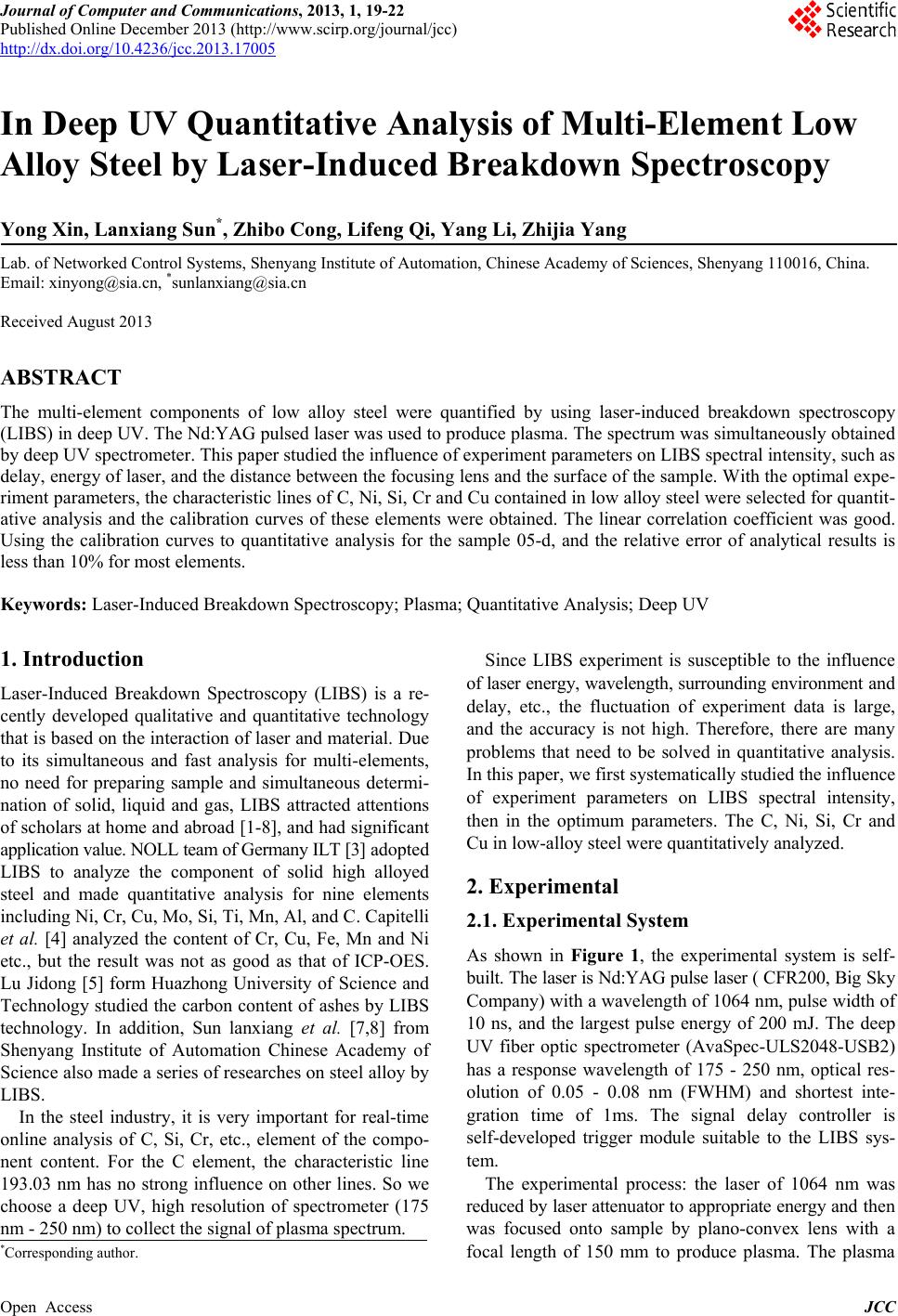
Journal of Computer and Communications, 2013, 1, 19-22
Published Online December 2013 (http://www.scirp.org/journal/jcc)
http://dx.doi.org/10.4236/jcc.2013.17005
Open Access JCC
In Deep UV Quantitativ e Anal ys is of Multi-Element Low
Alloy Steel by Laser-Induced Breakdown Spectroscopy
Yong Xin, Lanxiang Sun*, Zhibo Cong, Lifeng Qi, Yang Li, Zhijia Yang
Lab. of Networked Control Systems, Shenyang Institute of Automation, Chinese Academy of Sciences, Shenyang 110016, China.
Email: xinyong@sia.cn, *sunlanxiang@sia.cn
Received August 2013
ABSTRACT
The multi-element components of low alloy steel were quantified by using laser-induced breakdown spectroscopy
(LIBS) in deep UV. The Nd:YAG pulsed laser was used to produce plasma. The spectrum was simultaneously obtained
by deep UV spectrometer. This paper studied the influence of experiment parameters on LIBS spectral intensity, such as
delay, energy of laser, and the distance between the focusing lens and the surface of the sample. With the optimal exp e-
riment parameters, the characteristic lines of C, Ni, Si, Cr and Cu contained in low alloy steel were selected for quantit -
ative analysis and the calibration curves of these elements were obtained. The linear correlation coefficient was good.
Using the calibration curves to quantitative analysis for the sample 05-d, and the relative error of analytical results is
less than 10% for most elements.
Keywords: Laser-Induced Breakdown Spectroscopy; Plasma; Quantitative Analysis; Deep UV
1. Introduction
Laser-Induced Breakdown Spectroscopy (LIBS) is a re-
cently developed qualitative and quantitative technology
that is based on the interaction of laser and material. Due
to its simultaneous and fast analysis for multi-elements,
no need for preparing sample and simultaneous determi-
nation of solid, liquid and gas, LIBS attracted attentions
of scholars at home and abroad [1-8], and had significant
application value. NOLL team of Germany ILT [3] adopted
LIBS to analyze the component of solid high alloyed
steel and made quantitative analysis for nine elements
including Ni, Cr, Cu, Mo, Si, Ti, Mn, Al, and C. Capitelli
et al. [4] analyzed the content of Cr, Cu, Fe, Mn and Ni
etc., but the result was not as good as that of ICP-OES.
Lu Jidong [5] form Huazhong University of Science and
Technology studied the carbon content of ashes by LIBS
technology. In addition, Sun lanxiang et al. [7,8] from
Shenyang Institute of Automation Chinese Academy of
Science also made a series of researches on steel alloy by
LIBS.
In the steel industry, it is very important for real-time
online analysis of C, Si, Cr, etc., element of the compo-
nent content. For the C element, the characteristic line
193.03 nm has no strong influence on other lines. So we
choose a deep UV, high resolution of spectrometer (175
nm - 250 nm) to collect the signal of plasma spectrum.
Since LIBS experiment is susceptible to the influence
of laser energy, wavelength, surrounding environment and
delay, etc., the fluctuation of experiment data is large,
and the accuracy is not high. Therefore, there are many
problems that need to be solved in quantitative analysis.
In this pape r , we first systematically studied the influence
of experiment parameters on LIBS spectral intensity,
then in the optimum parameters. The C, Ni, Si, Cr and
Cu in low-alloy steel were quantitatively analyzed.
2. Experimental
2.1. Experimental System
As shown in Figure 1, the experimental system is self-
built. The lase r is Nd:Y AG pulse laser ( CFR20 0, Big Sky
Company) with a wavelength of 1064 nm, pulse width of
10 ns, and the largest pulse energy of 200 mJ. The deep
UV fiber optic spectrometer (AvaSpec-ULS2048-USB2)
has a response wavelength of 175 - 250 nm, optical res-
olution of 0.05 - 0.08 nm (FWHM) and shortest inte-
gration time of 1ms. The signal delay controller is
self-developed trigger module suitable to the LIBS sys-
tem.
The experimental process: the laser of 1064 nm was
reduced by laser attenuator to appropriate energy and then
was focused onto sample by plano-convex lens with a
focal length of 150 mm to produce plasma. The plasma
*